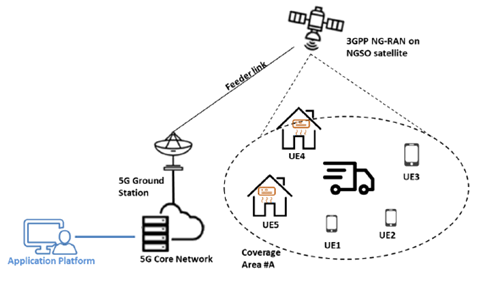Content for TR 22.865 Word version: 19.2.0
5.11 Use case on service differentiation for UEs via satellite access
5.11.1 Description
5.11.2 Pre-conditions
5.11.3 Service Flows
5.11.4 Post-conditions
5.11.5 Existing features partly or fully covering use case functionality
5.11.6 Potential New Requirements needed to support the use case
...
...
5.11 Use case on service differentiation for UEs via satellite access p. 28
5.11.1 Description p. 28
Satellite network has been introduced to 5G system to improve the service availability and reliability since 3GPP Rel-15. In parallel, various UE models with different capabilities (e.g. eMTC UE, CPE) are defined to serve the vertical needs. How to facilitate different types of UEs to benefit from satellite network is worthwhile to study.
The current assumption of 3GPP normative work is, UE shall be capable of GNSS positioning to determine the location for obtaining 5G services via satellite access, which has excluded the possibility to provide 5G services to UEs without GNSS receiver, or unable to determine the location with GNSS receiver. In fact, some services such as broadcast or multicast service, public safety associated services are not highly sensitive to the precise location. Moreover, UEs in stationary mobility type such as for home access, for metering have fixed location to support the position relevant operation during satellite access. The use case illustrates how the UEs with different capabilities obtain 5G services via satellite access.
5.11.2 Pre-conditions p. 28
It is assumed that network operator has deployed NGSO (e.g. LEO) satellite enabled NG-RAN to provide 5G network PLMN#X in the area Area#A, where have sparse population and no coverage of terrestrial access network as a result.
All UEs support 5G satellite RATs but with different subscription, positioning capabilities and mobility type as Table 5.11.2-1 shows.
| Subscription | Positioning Capability | Mobility Type | |
|---|---|---|---|
| UE1 | Subscriber of PLMN#X for eMBB services | No GNSS capability; Support other 3GPP positioning technologies | Full mobility |
| UE2 | Subscriber of other PLMN with roaming agreement to PLMN_X, for eMBB services | No GNSS capability; Support other 3GPP positioning technologies | Full mobility |
| UE3 | Subscriber of PLMN#X for MIoT services | No GNSS capability; Not support any 3GPP positioning technologies | Full mobility. |
| UE4 | Subscriber of PLMN#X for eMBB services | No GNSS capability; Not support any 3GPP positioning technologies | Stationary |
| UE5 | Subscriber of PLMN#X for eMBB services | No GNSS capability; Not support any 3GPP positioning technologies | unknown |
5.11.3 Service Flows p. 29
- All UEs are registering to PLMN_X to get services.
-
The network will provide the available services to authorized UEs considering UE's location, the subscription and etc.:
- UE1: the network can determine UE's location based on 3GPP positioning technologies, so it allows all the subscribed services after the location verification regarding regulatory requirements.
- UE2: the network can determine UE's location based on 3GPP positioning technologies, but only allows limit broadband services such as public safety related services and emergency call regarding the roaming agreement.
- UE3: the network can't determine UE's location, so limit the services to those such as emergency message (e.g. PWS message) regarding the operator's policy and regulatory requirements.
- UE4: the network knows UE4 is stationary and get the location from a reliable and trusted source. Then, the network allows subscribed eMBB services.
- UE5: the network detects UE5 is a dedicated user of digital broadband broadcast application, and fetch the location from the corresponding trusted application platform. Due to the lack of location verification, the network limits the services to those such as broadband broadcast services allowed by the regulatory requirements and the operator's policy.

Figure 5.11.3-1: Service differentiation for UEs via satellite access
(⇒ copy of original 3GPP image)
(⇒ copy of original 3GPP image)
5.11.4 Post-conditions p. 29
All UEs can successfully register to PLMN_X and get services based on the subscription, the regulatory requirements, the roaming agreement and the operator's policy.
5.11.5 Existing features partly or fully covering use case functionality p. 30
SA1 has introduced several requirements about satellite access in TS 22.261.
Clause 6.3.2.3 describes basic requirements about satellite access for 5G system and UE.
The 5G system shall be able to provide services using satellite access.
A UE supporting satellite access shall be able to provide or assist in providing its location to the 5G network.
A 5G system with satellite access shall be able to determine a UE's location in order to provide service (e.g. route traffic, support emergency calls) in accordance with the governing national or regional regulatory requirements applicable to that UE.
The 5G system with satellite access shall be able to support low power MIoT type of communications.
Regarding the above requirements, UE shall have the ability to provide or assist in providing the location for obtaining the services from 5G system. The restriction of UE's positioning capability has limited the potential users of 5G system using only satellite access, which expect to be served by 5G network.
5.11.6 Potential New Requirements needed to support the use case p. 30
[PR 5.11.6-001]
Subject to the regulatory requirements and operator's policy, the 5G system with satellite access shall be able to provide services to an authorized UE independently of the UE's GNSS capability.
[PR 5.11.6-002]
Subject to the regulatory requirements and operator's policy, the 5G system with satellite access shall be able to provide services to an authorized UE registered to VPLMN independently of the UE's GNSS capability.
[PR 5.11.6-003]
Subject to the operator's policy, the 5G system with satellite access shall be able to determine the location of a UE using only satellite access (e.g. based on 3GPP positioning technologies, based on the information from reliable and trusted sources) in order to provide services in accordance with the governing national or regional regulatory requirements applicable to that UE.